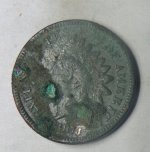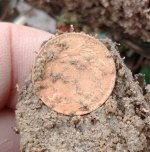ncclaymaker
Sr. Member
- Aug 26, 2011
- 370
- 315
- Detector(s) used
- Minelab 1000, A Motorized Power Glider Trike, 17 foot travel trailer behind my Jeep. 4" suction dredge/high banker.
- Primary Interest:
- Prospecting
Here in the slate belt of North Carolina, we have flour or fine gold galore. Our problem is extracting it from the other "stuff" before if gets off of end the sluice. Who knows, maybe this is a screwball Rube Goldberg of classifiers, but anything is worth a try... it may be better than nothing. I used a small production CNC machine to create this beveled punch plate using a scrap piece of Lexan, 10.5" X 19.0" X .220" . The cavities, all 984 of them, are created using a 0.5" X 45 degree V-bit at the top, and finished at the bottom with 0.25" X 60 degree V-bit for the bottom cut that pierces the bottom. I decided to use Lexan because it has good abrasive resistance qualities and relatively ease to machine on my CNC machine, instead of aluminium.
Since I classify everything to 3/16th or less before redirecting the suspended particulate matter to my Angus MacKirk Eureka sluice. Question is - how would you integrate a classifier or catchment device into the works to capture the fines. Hopefully, this could cause there may be enough of a "vortex" to help the fine gold particles to drop through, while letting the lighter particulate matter continue on. Forgot a small item... this will be attached to a 4" suction dredge that usually sucks up sand, magnetite, black sands and fine silt. Suggestions using miners moss, underflow, overflow, top or bottom area of the sluice or just send this idea to the trash can are cool. This guys skin is thick, but need some ideas, opinions, and satire if you wish.
The image files may help clarify the insanity of it all -
CNC router at work, boring the bottom of 984 beveled cavities -
View attachment 1218181
Cavities are aprox. 0.375" or 3/8" (9mm) in diameter X 0.22" (5mm) deep.
View attachment 1218182
41 rows X 21 columns
View attachment 1218192
Decided to work on this idea while the hurricane went elsewhere to disturb someone at the coast - Added some pics of the prototype.
The material layout is straightforward -
View attachment 1218549
The gray material is finer than miners moss, but perhaps adequate to entrap the fine particles that otherwise sail down the sluice. It's none other than Home Depot's ridge vent material. I did see a possible alternative at the following website http://www.floormatsystems.com/floor-mats/commercial-mats/vinyl-mesh-outdoor-entrance-floor-mat.html . This vinyl mesh can be had with or without the backing... an alternate "miners moss"?
View attachment 1218552 View attachment 1218558 View attachment 1218559
The assembly - without the rest of the sluice. I have to wait until the swollen stream that I parked it next to resides somewhat. Plan to attach this after my MacKirk Eureka to try to capture finer than "normal" particles. I've provided a 3mm gap between the plates and the "moss" to facilitate water movement and some "washing" action. Hope that it does not wash out the fines. The bottom end of the "moss" will be sealed with silicon but a gap will remain open to let the water flow out.
View attachment 1218861 View attachment 1218561 View attachment 1218567
My "Sly Banker" will be getting an enhanced silencer/muffler, so that you can be ten feet away and not hear the engine. Presently testing some tune-up ideas in a stream on our farm. Had to secure it high and dry during the hurricane rainfall. Water here is usually ankle deep.
View attachment 1218598
Since I classify everything to 3/16th or less before redirecting the suspended particulate matter to my Angus MacKirk Eureka sluice. Question is - how would you integrate a classifier or catchment device into the works to capture the fines. Hopefully, this could cause there may be enough of a "vortex" to help the fine gold particles to drop through, while letting the lighter particulate matter continue on. Forgot a small item... this will be attached to a 4" suction dredge that usually sucks up sand, magnetite, black sands and fine silt. Suggestions using miners moss, underflow, overflow, top or bottom area of the sluice or just send this idea to the trash can are cool. This guys skin is thick, but need some ideas, opinions, and satire if you wish.
The image files may help clarify the insanity of it all -
CNC router at work, boring the bottom of 984 beveled cavities -
View attachment 1218181
Cavities are aprox. 0.375" or 3/8" (9mm) in diameter X 0.22" (5mm) deep.
View attachment 1218182
41 rows X 21 columns
View attachment 1218192
Decided to work on this idea while the hurricane went elsewhere to disturb someone at the coast - Added some pics of the prototype.
The material layout is straightforward -
View attachment 1218549
The gray material is finer than miners moss, but perhaps adequate to entrap the fine particles that otherwise sail down the sluice. It's none other than Home Depot's ridge vent material. I did see a possible alternative at the following website http://www.floormatsystems.com/floor-mats/commercial-mats/vinyl-mesh-outdoor-entrance-floor-mat.html . This vinyl mesh can be had with or without the backing... an alternate "miners moss"?
View attachment 1218552 View attachment 1218558 View attachment 1218559
The assembly - without the rest of the sluice. I have to wait until the swollen stream that I parked it next to resides somewhat. Plan to attach this after my MacKirk Eureka to try to capture finer than "normal" particles. I've provided a 3mm gap between the plates and the "moss" to facilitate water movement and some "washing" action. Hope that it does not wash out the fines. The bottom end of the "moss" will be sealed with silicon but a gap will remain open to let the water flow out.
View attachment 1218861 View attachment 1218561 View attachment 1218567
My "Sly Banker" will be getting an enhanced silencer/muffler, so that you can be ten feet away and not hear the engine. Presently testing some tune-up ideas in a stream on our farm. Had to secure it high and dry during the hurricane rainfall. Water here is usually ankle deep.
View attachment 1218598
Last edited:
Upvote
0











